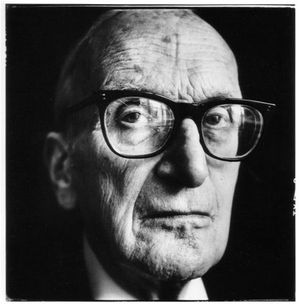Course:Law3020/2014WT1/Group I/Separation Thesis
| Natural Law | Positivism | Separation Thesis | System of Rights | Liberty-Paternalism | Law as Efficiency | Feminist Jurisprudence | Home (E. (Mrs.) v. Eve) |
Separation Thesis
Overview of Hart's Separation Theory
H.L.A. Hart is a modern legal positivist, and as such, believes that morality and law are completely separate. While morality and law can run parallel they are two distinct entities. The law does not need any intrinsic moral content.
However, Hart differs from the historical positivist theology. He says that law needs an inner quality that distinguishes it from other forms of rules. A special quality that has nothing to do with morality. Hart's answer this in his "ought to" analysis. That is, a law is elevated beyond a rule when it "ought to" have been adhered to.
Criteria for Hart's law
- The thing that makes legal rules special is they are not individually chosen.
- Legal rules are special in that they are backed up by the legal system.
- They must be rooted in the rule of recognition, which dictates that in order for law to be valid it must be recognized as such by the majority of society.
- The players in the legal system have to recognize that they should enforce this law, they are bound to do so, and it is right to do so.
- These rules need to be obeyed, and we need to obey them, for some reason other than punishment. We "ought to".
- If we all stop buying into the law, then it will lose the inherent power of law.
Hart's Role for Judges
Judges in common law have the job of interpreting the law. However, some cases cannot be adjudicated effectively by simple applying a statute. Hart calls these complex cases a Penumbra. These Penumbra cases requires that judges be active in their application of the law. However, Hart refutes the Legal Realism theology that considers judge made law to be completely dependent on societal pressures and individual bias. Instead, Hart puts forth his notion of rule governed practice.
Rule Governed Practice It's the legal system as a whole. There are principals the run through the entire body of law and the legal system itself. The activity of this Rule Governed Practice is what actively leads to consistent decision making in the context of Penumbra cases. Judges are obliged to conform to this rule and in doing so, formulate patterns that are relied on. One plausible example of a rule governed practice in modern society would be the The Canadian Charter of Rights and Freedoms. More particularly, how the value of personal autonomy is at the forefront of judges reasoning.
Fuller's Critique
Lon Fuller is one of Hart's greatest theological adversaries. He questions the entire premise of the separation of law and morality. Fuller's main argument against Separation Theory is the law itself has an Inner-Morality. He was largely influenced by the presence and impact of Nazi Germany during WWII.
Fuller's Inner Morality
In order for laws to be law, they must conform to the coherent, rational, and consistent moral understanding possessed by the people. He contends that the problem with the Nazi law is that it didn't reflect the inner morality of the people. Fuller sees law as more that just an artifact, it must have an inner quality that gives it life.
Fuller claims that Hart's theory doesn't have a clear definition of morality. Law cannot work as effective law unless is has moral characteristics.
Application to E. (Mrs.) v. Eve, [1986] 2 S.C.R. 388
This application will chose to focus on the ruling of the SCC and its applicability to Hart's theory of Rule Governed Practice. There is little doubt that Hart would describe this case within his Penumbra definition. There was no immediately relevant statutes to contend with the issue of non-therapeutic sterilization. The doctrine of parens patriae was initially used by the respondents to solidify their position, but ultimately wound up up costing them the decision.
The Doctrine of Parens Patriae
This doctrine invokes the courts participation when a person who is incapable of protecting themselves. The scope of the doctrine is relatively unlimited, but it has to conform to the underlying principals of protection. In this case, the doctrine could not be invoked by Mrs. E to sterilize her daughter. There was no evidence that not having the surgery would harm Eve directly, and the protections of the doctrine do not extend to a third party.
Ultimately, this doctrine could be viewed as an example of Hart's Rule Governed Practice. The judge used common law a principal to enact a decision that was consistent with precedent. Another more abstract example could be in regards to the earlier suggestion that the concept of personal autonomy was prevalent in the minds of the courts. In this case, there was no statutory law to apply. Therefore, the courts were free to apply the principal of personal autonomy that is in the body of law. This pattern had nothing to do with morality. It is rooted in the notion that for a law to be valid it must be recognized by the majority of society.
Fuller's Critique
Fuller would undoubtedly challenge Hart's position that the law in this case is separate from morality. There are analogies between the issue of sterilization in this case and the "bad laws" that are recognized by Fuller to be without inner morality. The issue of sterilization was statutorily regulated and implemented until, roughly, a decade before this case took place. Fuller would again argue that Hart's definition of morality is clearly mistaken. How can it be that judges recognize that self autonomy is an underlying "rule of governed practice" without recognizing its unique moral context. Or at the very least, it roots in societal interest.
Furthermore, Fuller would argue that the Parens Patriae doctrine is clearly not adjacent from morality. While Hart might argue that this is an example of when morality and law run parallel, this would be quickly dismissed. That when the court came its decision, it wasn't following law adjacent to morality, it was following law infused with morality.

